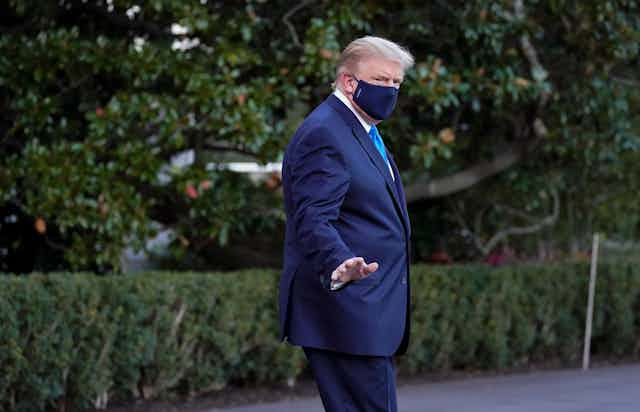With the announcement of President Donald Trump’s hospitalization for COVID-19, a dangerous situation is now unfolding at the White House.
It is hoped the president, first lady Melania Trump, other members of his staff and potentially White House workers and reporters — who have also tested positive — will have a speedy recovery from their personal health crises.
In many ways, the White House is now subject to the same type of pandemic business continuity and response issues that many workplaces have faced since February.
However, what is different is that the president is no ordinary worker and the White House is no ordinary workplace — the stakes are very high.
We can look to past presidential health crises to help us understand the current predicament that is unfolding in the midst of a global pandemic.
Reagan’s 1981 health crisis
The last time the U.S. came close to having its president incapacitated by a health crisis was an assassination attempt on Ronald Reagan on March 30, 1981. Shortly after being wounded, the 70-year-old president went into emergency surgery to remove a .22 calibre bullet from his chest. The surgery was quick and successful, and Reagan recovered to go on with his duties.

In reflecting on the aftermath of the 1981 assassination attempt and the resulting interruptions to White House operations, Martin Anderson, Reagan’s former assistant for policy development, stated: “It is amazing how much goes on in the government, in the White House, without someone ‘controlling’ it. It works, people do things. Life proceeds. They were just very careful.”
However, it was also observed that Reagan’s senior leadership did create some controversy during the management of the crisis in 1981. Secretary of State Alexander Haig implied that he was in control until Vice-President George H.W. Bush returned to the White House.
Under presidential lines of succession — as dictated by the 25th Amendment to the Constitution — Haig was not in control of the government, despite his statements. After Bush was quickly recalled to the White House from a speaking event in Texas, he immediately took on active crisis management roles in Washington. From the hospital, Reagan continued to make decisions and do the work of the president, despite actions taken to prepare the letters necessary to invoke the 25th Amendment.
What the 1981 assassination attempt tells us is that during a presidential health crisis, political figures will jockey for positions of power. Also, despite any such manoeuvres, there are firm rules in place that clearly delineate the process of presidential succession.
Even in the worst cases, the deliberate work of the U.S. government will continue in the event the president is temporarily incapacitated due to a health concern.
A perilous national security situation
But any personal health crisis related to the president and many of his senior aides is a situation of national security concern. Any interruption to White House operations as a result of the president’s illness is fraught with danger.
Given the number of people who may have been exposed to COVID-19 through interactions with the president this week, an immense contact tracing effort is now underway to determine the scope of the problem. Unfortunately, the risk of COVID-19 exposure may have been amplified due to Trump’s aversion to wearing masks.
The White House is a complicated workplace. It’s composed of spaces for the First Family’s residence, political and administrative offices as well as security and other operational functions. This makes any site-specific pandemic response effort extremely challenging.
The executive branch of the U.S. government works with a very wide array of people and agencies. They deal with sensitive information that can’t be brought home while the work site is being sanitized. Putting many members of the upper echelons of government into a 14-day quarantine is a complex undertaking.
Exposed vulnerabilities
A more dangerous complexity is also at play: the threat that the crisis may be exploited by adversaries. The presidential health crisis could draw focus away from pre-existing crises that need attention. As critical workers shift, regroup and adapt, vulnerabilities may be left open and exploited.
Immediately after the 1981 assassination attempt on Reagan, national security advisers were concerned that a larger plot may have been unfolding. Could incapacitating the president have been part of a co-ordinated operation, ending with the Soviet Union using the window of opportunity to stage an invasion of Poland? History tells us the Soviets did not exploit Reagan’s assassination attempt to their advantage.
But given today’s highly polarized American electorate and the spectre of foreign interference with the upcoming election, there exists the potential for any leadership crisis in Washington to be exploited.
Question of government stability
Even in the worst-case scenarios regarding Trump’s health, provisions like the 25th Amendment mean U.S. government operations are not dependent on a single position or personality. However, given the unpredictable nature of events in 2020 and the chaotic temperament of the president, there are still reasons for concern about the stability of the U.S. government.
For operations to continue, the president and senior political leadership must make informed, science-based decisions to manage the COVID-19 crisis at the White House. At the same time, Trump and his senior advisers must be willing to work within the rules established for decades related to continuity of government.
Unfortunately, Trump is not known for following the rules — look no further than his performance in the first presidential debate.
Now is not the time for ignoring the rules and dismissing COVID-19 safety measures. A threshold has been crossed: COVID-19 is a disastrous public health issue in the U.S., but with Trump’s diagnosis and resulting hospitalization, it has now morphed into a potential government crisis.

